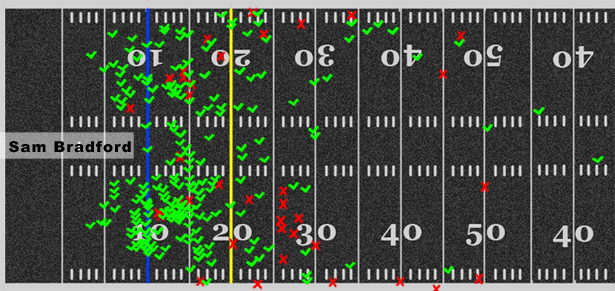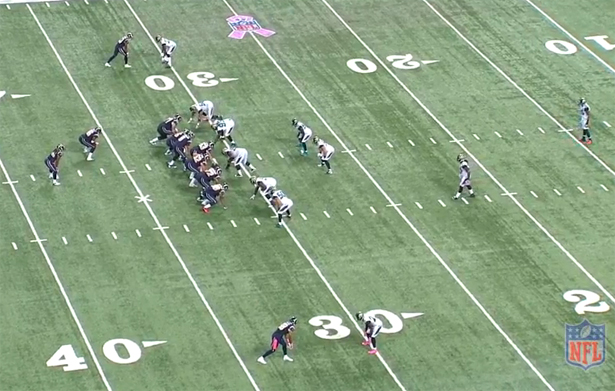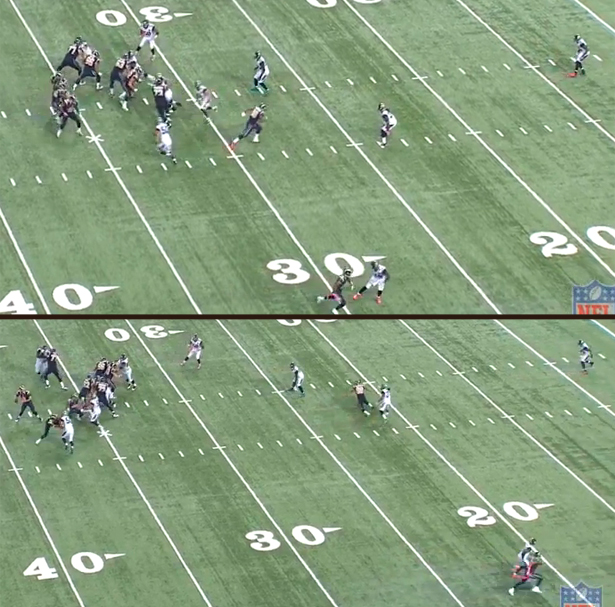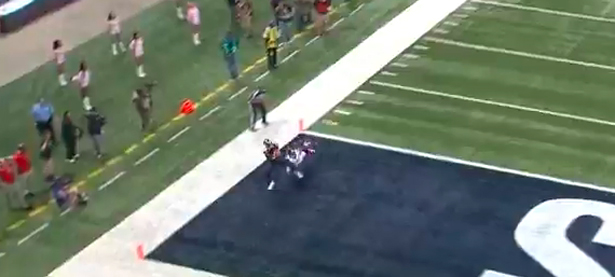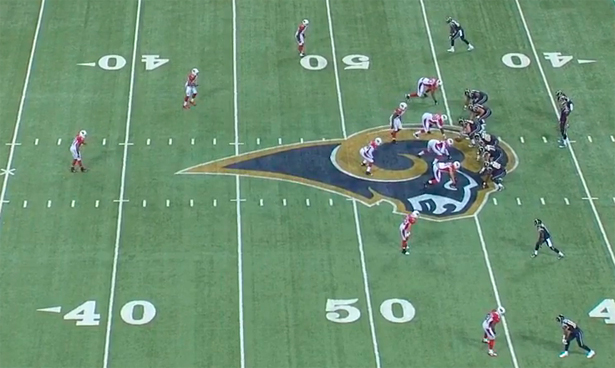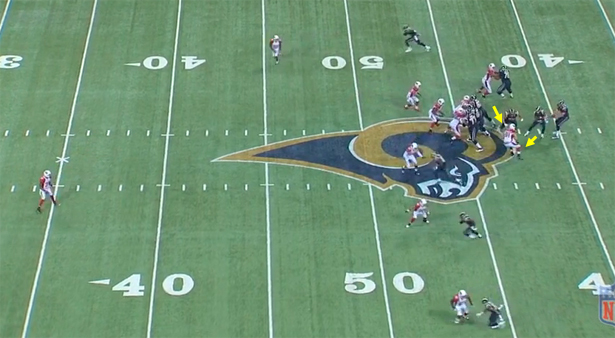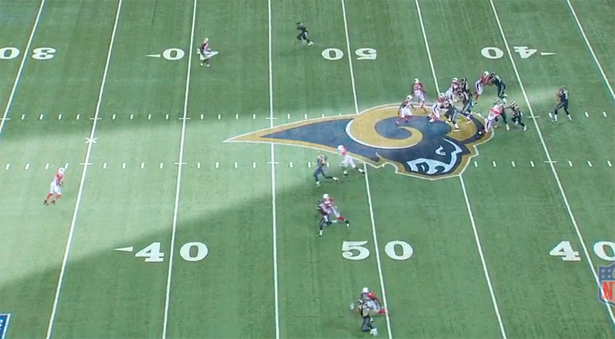- Joined
- Mar 13, 2015
- Messages
- 109
- Name
- Ramsey
http://bleacherreport.com/articles/...agles-offense-chip-kelly-must-find-qb-in-2015
Nick Foles Not the Answer for Eagles Offense, Chip Kelly Must Find QB in 2015
By Cian Fahey, Featured Columnist Feb 9, 2015
Kelly has been in the NFL for two seasons now. He inherited a relatively strong roster from Andy Reid after the 2012 season, so he was quickly able to lead the Philadelphia Eagles to consecutive 10-6 seasons and one playoff appearance.
Though Reid left him a talented roster on the whole in comparison to most inherited rebuilding projects, he didn't leave him an established quarterback of starting quality.
Therefore, even though Kelly has made a trip to the playoffs and is having a philosophical impact on the league as a whole, he still needs to tie his future to a quarterback. To this point, the 51-year-old has had three starting quarterbacks: Michael Vick, Nick Foles and Mark Sanchez.
Vick and Foles were inherited from the Reid era. Vick was an established starter who was firmly in the latter stages of his career when Kelly arrived in Philadelphia. Foles was largely still an unknown. He had been selected in the third round of the 2012 draft and started just six games as a rookie.
Though Vick entered the season as Kelly's starting quarterback, he didn't last long in that role. By Week 6, the Eagles were 2-3 and Foleshad just taken over as the starter.
Foles threw for 24 touchdowns and just two interceptions while helping the Eagles to an 8-2 record. His incredible touchdown-to-interception ratio for the season as a whole, 27-2, was the greatest of any quarterback through NFL history.
In 2014, Foles fell back to earth and struggled before suffering an injury that prematurely ended his season. That injury means that the greatest argument for staying committed to Foles remains his play in 2013.
His play in 2013 is the wrong term, though. His play in 2013 isn't what makes Foles intriguing to Eagles fans, it's his production. His production that isn't really his.
The NFL applies passing stats to quarterbacks individually, but realistically they are a culmination of different elements. No quarterback in the NFL has the same responsibilities as the other 31 starters, and no quarterback has the same supporting cast.
Responsibilities and assignments have major impacts on the individual production of a quarterback, and they do vary dramatically from team to team. In order to assess Foles' value moving forward, we need to isolate his play from his production and break down the impact of his supporting cast and responsibilities during that historic 2013 season.
This chart racks every single throw Foles made in 2013.

Cian Fahey
Every green tick is an accurate pass and every red cross is an inaccurate pass. Whether Foles' throw was caught or not is irrelevant for this specific chart because it is attempting to isolate Foles' accuracy. It doesn't include throwaways, spikes or passes deflected at the line of scrimmage.
A large number of things stand out from this chart when you compare it to those done for other quarterbacks.
Most significant is the huge number of passes Foles threw to receivers behind the line of scrimmage. Kelly's offense allowed Foles to rely heavily on screen passes, checkdowns and designed option throws to the flat.
Teams typically can't attempt so many passes behind the line of scrimmage because it becomes predictable and limits the efficiency and explosiveness of the offense as a whole.
For the Eagles, that wasn't a problem.

Cian Fahey
Kelly's play-calling was intelligent enough to keep defenses off balance, while he used a greater variety of complex and simple screens than any other coach in the NFL. Foles regularly threw the ball to his running backs, receivers and tight ends from sideline to sideline.
That creativity put talented players in position to create yardage after the catch. Unsurprisingly, over half of Foles' passing yards in 2013 came after the catch. When you combine that with a phenomenal running game that was first in DVOA by a huge margin, the Eagles could take a huge amount of stress off of the quarterback position while still dictating the game by staying ahead of the down and distance.
Executing screen plays in the NFL isn't as simple as it seems, but for NFL quarterbacks they should rarely result in an interception.
For Foles to throw an interception on any of these plays, he would have to have had a severe mental lapse or been very inaccurate on what is considered a routine throw for quarterbacks at this level. Any quarterback who is used this way is going to have a bloated completion percentage and an inflated touchdown-to-interception ratio.
Seventy-six of Foles' qualifying pass attempts were thrown behind the line of scrimmage in 2013. He only attempted 350 passes, so 22 percent of his throws were extremely safe.
Safe throws are a staple of Kelly's passing attack. He spreads the offense out and uses different route combinations to put his receivers in space. The quarterback still has to find the right option, somethingFoles was good but not great at, but he is consistently gaining easy yardage because of play design.
If you take any of his games from 2013, you will find examples of Kelly's scheme creating easy, important yardage. For example, here are three from the Week 17 victory over the Dallas Cowboys.
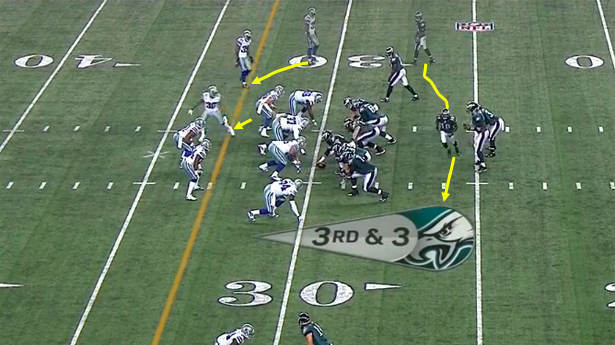
Credit: NFL.com
For their first third down of the game, the Eagles were in a manageable 3rd-and-3 situation at their own 30-yard line. Before the ball was snapped, the Eagles motioned DeSean Jackson from his right wide receiver position so that he ran in front of the quarterback and arrived in the opposing slot.
The defense responded by moving their left cornerback into the slot on that side of the field while the slot cornerback followed Jackson into the opposing flat. That movement told the quarterback that the defense was likely in man coverage.

Credit: NFL.com
At the snap, Foles knows that he has a simple read to the right side. If the outside cornerback follows the receiver infield, then his running back outside is going to be left in a huge amount of space. One of the linebackers over the middle of the field is responsible for the running back, and he can't fight through the traffic to get close to Foles' intended target.
This is the kind of play that is simple for average NFL quarterbacks. It resulted in 34 yards.
From there the Eagles would settle for a field goal, but another easy play for the quarterback would soon directly lead to a touchdown.
Once again, the Eagles motioned Jackson away from his right wide receiver position. This time he settled next to Foles in the backfield, on the other side of LeSean McCoy. The cornerback, who initially lined up over Jackson, followed him so that he was directly across from him.
Foles should expect man coverage again on this play, but it's largely inconsequential either way.

Credit: NFL.com
At the snap, Foles holds the ball out for Jackson to take on a rushing attempt. The Eagles offensive line and the tight end to the right side all flow with Jackson on a zone-blocking type of movement toward the left side.
This draws the attention of all but one Cowboys defender, the cornerback to the other side of the screen.
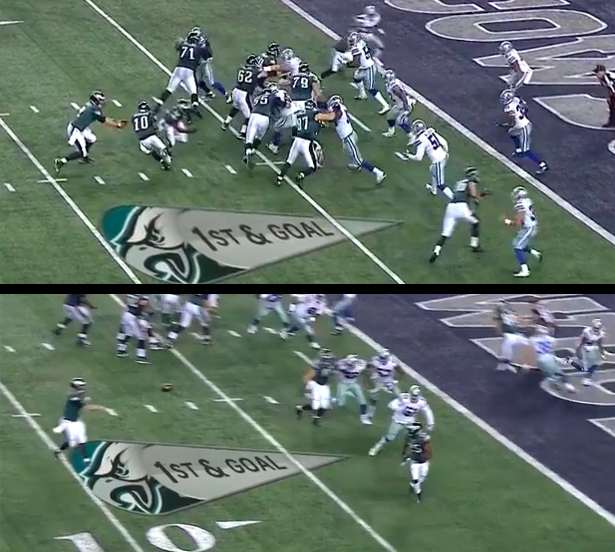
Credit: NFL.com
While Jackson's play fake was being carried out, McCoy was running in the opposite direction to attack the flat on the right side of the field. McCoy is one of the fastest players in the NFL, so as soon as he got level with the edge defender on the left side he was going to be wide open.
That edge defender was still being drawn toward Jackson as McCoy escaped to the outside. Foles had a simple throw to his running back for a touchdown.
Many of the concepts that Kelly uses to ease his quarterback's reads and create separation for his receivers are similar. He understands how to attack space underneath and use the alignment of his targets to stretch the defense horizontally as well as vertically.
For Foles' second touchdown of the quarter, we saw Kelly's offense working simply but effectively.
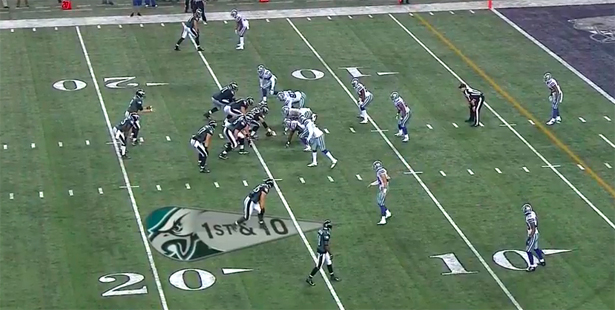
Credit: NFL.com
On 1st-and-10, the Eagles come out with a formation that is typical of Kelly's offense. It is a balanced look with one backside receiver alone, one tight end to the right and two receivers outside of him. McCoy's presence in the backfield alongside Foles forces the defense to not only respect, but prioritize, the run.
By prioritizing the run, the defense exposes itself on the edges.
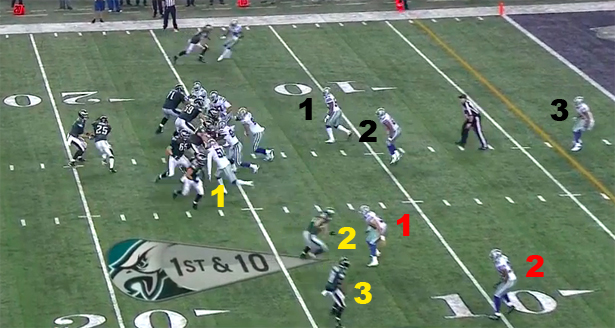
Credit: NFL.com
The Cowboys want to be aggressive against the run, so their edge-rusher attacks the pocket as soon as McCoy moves across Foles' face. On the second level, the three defenders in the middle of the field have their eyes in the backfield.
Therefore, when the Eagles tight end leaks out into his route, Kelly has created a three-on-two situation on the outside.
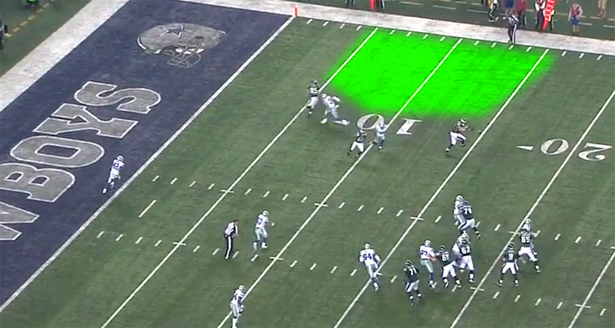
Credit: NFL.com
Both of Philadelphia's outside receivers to the right side run routes that break infield. This draws both defensive backs to that side in man coverage, leaving the tight end to run into the flat uncovered. Folesthrows the ball to the tight end, who has a simple task of catching and turning to run into the end zone.
Foles had a very simple read to make on this play again. The defense blew an assignment because of the threat of the running game, and the design of the routes allowed the offense to take advantage of the space.
None of these three plays saw Foles throw the ball behind the line of scrimmage, but each was essentially an extended handoff. Each throw was simple because of how the play design worked against the defense. Foles deserves credit for executing these plays effectively and consistently.

Cian Fahey
While crediting Foles for his consistency in this area, it must also be noted that these types of low-difficulty plays have severely influenced his perceived ability to take care of the football.
Though Foles only had two caught interceptions during the 2013 season, he had 19 interceptable passes. Without adjusting for scheme, that is a ratio of 18.4 attempts, a less than impressive ratio when compared to numbers of other quarterbacks during the 2014 season.
Foles had a very similar ratio in 2014.
Luck has played a large role in Foles' low turnover ratio to this point in his career. That was highlighted more in 2014 when his supporting cast began to falter and teams began to focus on shutting down the running game, forcing Foles to beat them by throwing the ball downfield.
He was inconsistent throwing the ball down the field in 2014, and it should have come as no surprise because he had similar inconsistency in 2013. It was just overshadowed by his production.
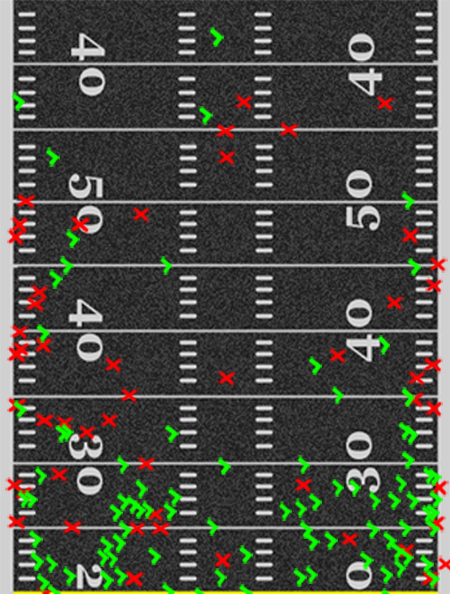
Cian Fahey
This chart tracks all of Foles' throws that landed at least 10 yards away from the line of scrimmage in 2013. On intermediate throws to the outside, Foles was largely accurate. He understood how to read the defense and execute Kelly's offense, so he was able to consistently find wide-open receivers from within the pocket.
He also showed some ability to extend plays and throw accurately while on the move to these areas of the field.
It was when Foles was asked to push the ball further downfield that he struggled. Too often, Foles was reliant on his wide receivers to adjust to the ball in the air or win at the catch point with their size. Much likeAndy Dalton of the Cincinnati Bengals, Foles is more of a downfield floater than a downfield thrower.
This means he doesn't have great arm strength or the ability to consistently place the ball precisely past 20 yards downfield.
Because of the design of Kelly's offense, he doesn't need a quarterback with incredible precision. He needs a quarterback who can work from the pocket and make quick decisions to locate open receivers downfield. Foles regularly locates his receivers, but even when they are wide open he can struggle to find them.
Against lesser defenses, the Eagles were able to get away with missing these opportunities, but when the defense elevated its level of play, these missed opportunities proved decisive.
The most worrying sign for the Eagles is that Foles appeared to regress in this area from 2013 to 2014.
Part of his struggles could be attributed to the loss of Jackson and the decline in performances from other targets, Riley Cooper in particular, at the catch point. Jeremy Maclin had an excellent season, but he is less of a deep threat than Jackson was, while Jordan Matthews is largely reliant on scheme to get open.

Credit: NFL.com
This is the issue with Foles, though. When he wasn't in a perfect situation, he couldn't elevate his teammates. He simply misses too many throws downfield, regardless of who he was playing with. That is the biggest reason why Kelly needs to move on from him.
Maybe it's a coincidence or maybe there are currently unknown details that will be revealed later, but Kelly recently took over more personnel control with the Eagles in anticipation of the draft that boasts the best quarterback he coached at Oregon.
Reports have already emerged suggesting that the Eagles areattempting to move up to draft Marcus Mariota.
Some form of a trade is likely going to be the Eagles' best way to attain a new starter. Only two quarterbacks in the draft appear to be viable starters, Mariota and Jameis Winston, while the free-agency class is poor at the position.
Kelly isn't likely to ever be in position to select a top quarterback in the draft. If his team is picking in the top five, he will likely have been fired. Furthermore, his offensive scheme works so well with average to below-average quarterbacks that it's unlikely his teams will ever fall that far anyway.
The past two seasons for Kelly have mostly been positive. He is a largely beloved coach at a time when beloved coaches are few and far between.
Yet, if he never finds an above-average quarterback to tie his career to, this early optimism may quickly turn to frustration at missed opportunities.
Nick Foles Not the Answer for Eagles Offense, Chip Kelly Must Find QB in 2015
By Cian Fahey, Featured Columnist Feb 9, 2015
Kelly has been in the NFL for two seasons now. He inherited a relatively strong roster from Andy Reid after the 2012 season, so he was quickly able to lead the Philadelphia Eagles to consecutive 10-6 seasons and one playoff appearance.
Though Reid left him a talented roster on the whole in comparison to most inherited rebuilding projects, he didn't leave him an established quarterback of starting quality.
Therefore, even though Kelly has made a trip to the playoffs and is having a philosophical impact on the league as a whole, he still needs to tie his future to a quarterback. To this point, the 51-year-old has had three starting quarterbacks: Michael Vick, Nick Foles and Mark Sanchez.
Vick and Foles were inherited from the Reid era. Vick was an established starter who was firmly in the latter stages of his career when Kelly arrived in Philadelphia. Foles was largely still an unknown. He had been selected in the third round of the 2012 draft and started just six games as a rookie.
Though Vick entered the season as Kelly's starting quarterback, he didn't last long in that role. By Week 6, the Eagles were 2-3 and Foleshad just taken over as the starter.
Foles threw for 24 touchdowns and just two interceptions while helping the Eagles to an 8-2 record. His incredible touchdown-to-interception ratio for the season as a whole, 27-2, was the greatest of any quarterback through NFL history.
In 2014, Foles fell back to earth and struggled before suffering an injury that prematurely ended his season. That injury means that the greatest argument for staying committed to Foles remains his play in 2013.
His play in 2013 is the wrong term, though. His play in 2013 isn't what makes Foles intriguing to Eagles fans, it's his production. His production that isn't really his.
The NFL applies passing stats to quarterbacks individually, but realistically they are a culmination of different elements. No quarterback in the NFL has the same responsibilities as the other 31 starters, and no quarterback has the same supporting cast.
Responsibilities and assignments have major impacts on the individual production of a quarterback, and they do vary dramatically from team to team. In order to assess Foles' value moving forward, we need to isolate his play from his production and break down the impact of his supporting cast and responsibilities during that historic 2013 season.
This chart racks every single throw Foles made in 2013.

Cian Fahey
Every green tick is an accurate pass and every red cross is an inaccurate pass. Whether Foles' throw was caught or not is irrelevant for this specific chart because it is attempting to isolate Foles' accuracy. It doesn't include throwaways, spikes or passes deflected at the line of scrimmage.
A large number of things stand out from this chart when you compare it to those done for other quarterbacks.
Most significant is the huge number of passes Foles threw to receivers behind the line of scrimmage. Kelly's offense allowed Foles to rely heavily on screen passes, checkdowns and designed option throws to the flat.
Teams typically can't attempt so many passes behind the line of scrimmage because it becomes predictable and limits the efficiency and explosiveness of the offense as a whole.
For the Eagles, that wasn't a problem.

Cian Fahey
Kelly's play-calling was intelligent enough to keep defenses off balance, while he used a greater variety of complex and simple screens than any other coach in the NFL. Foles regularly threw the ball to his running backs, receivers and tight ends from sideline to sideline.
That creativity put talented players in position to create yardage after the catch. Unsurprisingly, over half of Foles' passing yards in 2013 came after the catch. When you combine that with a phenomenal running game that was first in DVOA by a huge margin, the Eagles could take a huge amount of stress off of the quarterback position while still dictating the game by staying ahead of the down and distance.
Executing screen plays in the NFL isn't as simple as it seems, but for NFL quarterbacks they should rarely result in an interception.
For Foles to throw an interception on any of these plays, he would have to have had a severe mental lapse or been very inaccurate on what is considered a routine throw for quarterbacks at this level. Any quarterback who is used this way is going to have a bloated completion percentage and an inflated touchdown-to-interception ratio.
Seventy-six of Foles' qualifying pass attempts were thrown behind the line of scrimmage in 2013. He only attempted 350 passes, so 22 percent of his throws were extremely safe.
Safe throws are a staple of Kelly's passing attack. He spreads the offense out and uses different route combinations to put his receivers in space. The quarterback still has to find the right option, somethingFoles was good but not great at, but he is consistently gaining easy yardage because of play design.
If you take any of his games from 2013, you will find examples of Kelly's scheme creating easy, important yardage. For example, here are three from the Week 17 victory over the Dallas Cowboys.

Credit: NFL.com
For their first third down of the game, the Eagles were in a manageable 3rd-and-3 situation at their own 30-yard line. Before the ball was snapped, the Eagles motioned DeSean Jackson from his right wide receiver position so that he ran in front of the quarterback and arrived in the opposing slot.
The defense responded by moving their left cornerback into the slot on that side of the field while the slot cornerback followed Jackson into the opposing flat. That movement told the quarterback that the defense was likely in man coverage.

Credit: NFL.com
At the snap, Foles knows that he has a simple read to the right side. If the outside cornerback follows the receiver infield, then his running back outside is going to be left in a huge amount of space. One of the linebackers over the middle of the field is responsible for the running back, and he can't fight through the traffic to get close to Foles' intended target.
This is the kind of play that is simple for average NFL quarterbacks. It resulted in 34 yards.
From there the Eagles would settle for a field goal, but another easy play for the quarterback would soon directly lead to a touchdown.
Once again, the Eagles motioned Jackson away from his right wide receiver position. This time he settled next to Foles in the backfield, on the other side of LeSean McCoy. The cornerback, who initially lined up over Jackson, followed him so that he was directly across from him.
Foles should expect man coverage again on this play, but it's largely inconsequential either way.

Credit: NFL.com
At the snap, Foles holds the ball out for Jackson to take on a rushing attempt. The Eagles offensive line and the tight end to the right side all flow with Jackson on a zone-blocking type of movement toward the left side.
This draws the attention of all but one Cowboys defender, the cornerback to the other side of the screen.

Credit: NFL.com
While Jackson's play fake was being carried out, McCoy was running in the opposite direction to attack the flat on the right side of the field. McCoy is one of the fastest players in the NFL, so as soon as he got level with the edge defender on the left side he was going to be wide open.
That edge defender was still being drawn toward Jackson as McCoy escaped to the outside. Foles had a simple throw to his running back for a touchdown.
Many of the concepts that Kelly uses to ease his quarterback's reads and create separation for his receivers are similar. He understands how to attack space underneath and use the alignment of his targets to stretch the defense horizontally as well as vertically.
For Foles' second touchdown of the quarter, we saw Kelly's offense working simply but effectively.

Credit: NFL.com
On 1st-and-10, the Eagles come out with a formation that is typical of Kelly's offense. It is a balanced look with one backside receiver alone, one tight end to the right and two receivers outside of him. McCoy's presence in the backfield alongside Foles forces the defense to not only respect, but prioritize, the run.
By prioritizing the run, the defense exposes itself on the edges.

Credit: NFL.com
The Cowboys want to be aggressive against the run, so their edge-rusher attacks the pocket as soon as McCoy moves across Foles' face. On the second level, the three defenders in the middle of the field have their eyes in the backfield.
Therefore, when the Eagles tight end leaks out into his route, Kelly has created a three-on-two situation on the outside.

Credit: NFL.com
Both of Philadelphia's outside receivers to the right side run routes that break infield. This draws both defensive backs to that side in man coverage, leaving the tight end to run into the flat uncovered. Folesthrows the ball to the tight end, who has a simple task of catching and turning to run into the end zone.
Foles had a very simple read to make on this play again. The defense blew an assignment because of the threat of the running game, and the design of the routes allowed the offense to take advantage of the space.
None of these three plays saw Foles throw the ball behind the line of scrimmage, but each was essentially an extended handoff. Each throw was simple because of how the play design worked against the defense. Foles deserves credit for executing these plays effectively and consistently.

Cian Fahey
While crediting Foles for his consistency in this area, it must also be noted that these types of low-difficulty plays have severely influenced his perceived ability to take care of the football.
Though Foles only had two caught interceptions during the 2013 season, he had 19 interceptable passes. Without adjusting for scheme, that is a ratio of 18.4 attempts, a less than impressive ratio when compared to numbers of other quarterbacks during the 2014 season.
Foles had a very similar ratio in 2014.
Luck has played a large role in Foles' low turnover ratio to this point in his career. That was highlighted more in 2014 when his supporting cast began to falter and teams began to focus on shutting down the running game, forcing Foles to beat them by throwing the ball downfield.
He was inconsistent throwing the ball down the field in 2014, and it should have come as no surprise because he had similar inconsistency in 2013. It was just overshadowed by his production.

Cian Fahey
This chart tracks all of Foles' throws that landed at least 10 yards away from the line of scrimmage in 2013. On intermediate throws to the outside, Foles was largely accurate. He understood how to read the defense and execute Kelly's offense, so he was able to consistently find wide-open receivers from within the pocket.
He also showed some ability to extend plays and throw accurately while on the move to these areas of the field.
It was when Foles was asked to push the ball further downfield that he struggled. Too often, Foles was reliant on his wide receivers to adjust to the ball in the air or win at the catch point with their size. Much likeAndy Dalton of the Cincinnati Bengals, Foles is more of a downfield floater than a downfield thrower.
This means he doesn't have great arm strength or the ability to consistently place the ball precisely past 20 yards downfield.
Because of the design of Kelly's offense, he doesn't need a quarterback with incredible precision. He needs a quarterback who can work from the pocket and make quick decisions to locate open receivers downfield. Foles regularly locates his receivers, but even when they are wide open he can struggle to find them.
Against lesser defenses, the Eagles were able to get away with missing these opportunities, but when the defense elevated its level of play, these missed opportunities proved decisive.
The most worrying sign for the Eagles is that Foles appeared to regress in this area from 2013 to 2014.
Part of his struggles could be attributed to the loss of Jackson and the decline in performances from other targets, Riley Cooper in particular, at the catch point. Jeremy Maclin had an excellent season, but he is less of a deep threat than Jackson was, while Jordan Matthews is largely reliant on scheme to get open.

Credit: NFL.com
This is the issue with Foles, though. When he wasn't in a perfect situation, he couldn't elevate his teammates. He simply misses too many throws downfield, regardless of who he was playing with. That is the biggest reason why Kelly needs to move on from him.
Maybe it's a coincidence or maybe there are currently unknown details that will be revealed later, but Kelly recently took over more personnel control with the Eagles in anticipation of the draft that boasts the best quarterback he coached at Oregon.
Reports have already emerged suggesting that the Eagles areattempting to move up to draft Marcus Mariota.
Some form of a trade is likely going to be the Eagles' best way to attain a new starter. Only two quarterbacks in the draft appear to be viable starters, Mariota and Jameis Winston, while the free-agency class is poor at the position.
Kelly isn't likely to ever be in position to select a top quarterback in the draft. If his team is picking in the top five, he will likely have been fired. Furthermore, his offensive scheme works so well with average to below-average quarterbacks that it's unlikely his teams will ever fall that far anyway.
The past two seasons for Kelly have mostly been positive. He is a largely beloved coach at a time when beloved coaches are few and far between.
Yet, if he never finds an above-average quarterback to tie his career to, this early optimism may quickly turn to frustration at missed opportunities.

